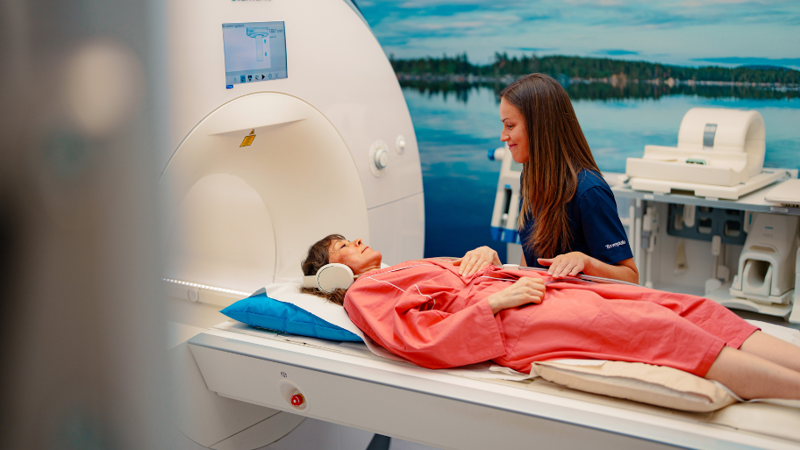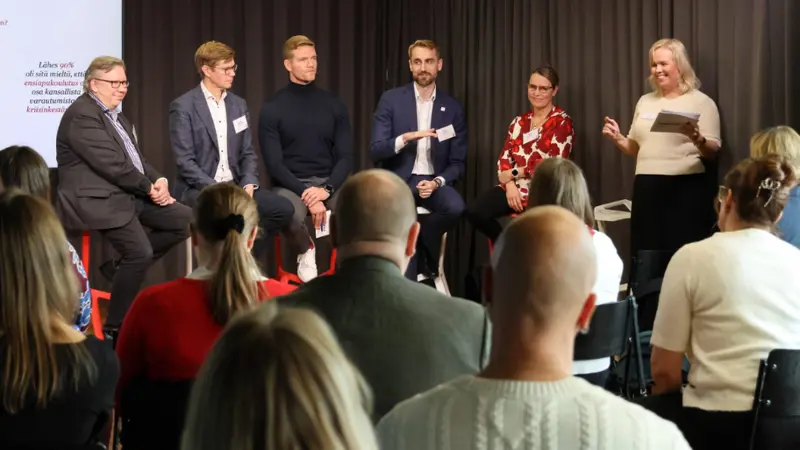Without systematicity and systemicity, foresight lacks depth
Only by identifying alternative futures and the drivers of change that influence them can we make choices for the future we want. By being an active player, we become the architects of the future, rather than its victims. At Terveystalo's event "Tulevaisuuden Työelämän Tekijät", futurist Minna Koskelo highlighted the drivers of change that all organisations should be aware of.

In many ways, the world of work is at an inflection point, with many opportunities but also many uncertainties. The way to deal with uncertainty is to anticipate and prepare for alternative futures.
– The future belongs to all of us, each of us has the power to shape it. Even now, every decision we make shapes the future we all share. It is good for organisations to have a shared vision of the desired future and to actively strive every day to make choices that bring us closer to that future, says Koskelo.
Choices instead of drift
Koskelo himself uses the PESTEC model to model the future, which looks at six aspects that influence the operating environment: political, economic, social, technological, environmental and cultural. For each of these, we see the drivers of the future with different emphases; megatrends, counter-trends or even weak signals.
– The impact of each on your business varies from company to company and from sector to sector. Some are more pronounced in information work, some in competitive sectors, some in physical work. There are also so-called unpleasant jokers, which you can only prepare for if you are aware of them. As an active player, you can try to weaken the drivers of change if they become stronger and take the future further away from what you want, says Koskelo.
6 drivers of change in the environment
1) The human revolution at work
A shrinking workforce provides an incentive to ensure employee wellbeing - security alone does not create intrinsic motivation, making workers more productive and innovative. Despite the current challenging economic climate, there is a case for investing in people's wellbeing and keeping them fit for work. Personal life needs to be reconciled with working life, and the human revolution means flexibility and lifecycle design.
To do otherwise is to risk losing talent, whose negative experiences can spread very quickly and widely.
2) Value and value-added
This driver has emerged in particular with the war of aggression launched by Russia. The importance of companies as solvers of world problems for both employees and customers is highlighted in all the research findings. The value ethic challenges companies to communicate their impact and values, as companies and brands are expected to take a stand on social issues - especially in their own sector.
3) Multi-modal labour market and multi-potential
Employers have always faced the challenge of retention. Changing ways of working, from linear and chronological to multi-tasking to light entrepreneurship, have added a further cornerstone to engagement in recent years. If in the past professional identity was limited to strict expertise, today the generalist is mainstream and so-called slash-and-burn jobs have multiple meanings. But the keys to engagement are familiar: good employee experience and leadership are the keys to success. Just as people want flexibility, they also look to employers for stability and the security that comes with long service. The employer's investment in staff skills may have already been used in the past, for example through volunteering; the multi-modal labour market allows the same skills to be used as a source of income.
4) A diverse and multi-age working life
Four different generations may currently be working in the workplace. Age is no longer so important for employment, but work capacity management needs to take into account the needs of different ages and shape work accordingly. In the future, diversity and inclusion will have progressed beyond ethnicity and gender to include neurodiversity and we recognise that different brains require different attention in the workplace. In addition to training staff, designing the work environment can ensure that it provides a pleasant employee experience for a diverse workforce.
5) An artificially intelligent future
For an idea about the future to be useful, it must first be ridiculous. This is the case with Dator's Law, a well-known foresight term named after its author - the renowned futurist Jim Dator. Not many people could have imagined, even at the beginning of the decade, that the use of artificial intelligence and its various manifestations would now grow at an exponential rate. It's as if the cork on a ketchup bottle had come off. In creating a culture of use, everyone should be at the forefront, or be forced to adopt the creations of others. At the very least, the choice to remain a bystander and wait for the human-centred metaverse to create its framework must be made consciously.
6) A planet-centric future
How would the solution devised change if the focus were on the planet instead of humans? While technology is reshaping work and shifting certain outputs and tasks away from humans, it is estimated that new jobs will be created in the coming years thanks to nature-based solutions. The industries and businesses generated by the circular economy will compete for the same talent through their strong value-based approach.
Foresight grows by doing
Organisations also need to make choices about which issues they want to be pioneers and thought leaders on, and which issues they can stay ahead of.
– The key is to become farsighted and regularly look at the drivers of change. You need to think about the threats to the future and how to address them, as well as the opportunities and how to seize them. Only then can you understand which signals are important for your business and which you can consciously ignore, because without interpretation in your own context, foresight is pretty much useless nice-to-know information, advises Koskelo.
Read more occupational health articles

Terveystalo's digital services have been awarded the internationally recognized ISO27001 information security certification.
Terveystalo's information security practices, processes, and risk management are in line with international best practices.

Does massage help relieve stress? – Touch restores and calms the body and mind
Stress is not always visible on the outside, but the body does show signs when the strain increases. According to Lassi Ylönen, a trained massage therapist at Terveystalo Rela, the body often communicates stress through subtle signs.

Circular economy and artificial intelligence boost performance and improve care
At the heart of sustainable healthcare, technology serves as a tool for improving both the quality of care and accountability. Terveystalo favors solutions that combine sustainability, cost-effectiveness, and medical expertise.

Psychologist: How to make Christmas a relaxed and personal celebration
For many, the anticipation of Christmas begins when cities are decked out in seasonal lights and the first chocolates, calendars, and gingerbread cookies appear on store shelves. Christmas carols ring out and the Tonttuparaati choir sings “Kiire jo on! Kiire jo on!” (Hurry up! Hurry up!). This warm and atmospheric celebration also brings other feelings to mind: how on earth can we get through all this without losing our joy and peace in the rush?

Terveystalo and Gosta Labs deepen their cooperation: the goal is to streamline work with a superior patient information system
Terveystalo is deepening its cooperation with Finnish health technology company Gosta Labs and investing €1 million in the company as a minority investor. The aim is to jointly develop artificial intelligence solutions that improve the quality of care and the efficiency of reception work as part of Terveystalo's new patient information system, Terveystalo Ella.

First aid preparedness in companies requires action and courage
First aid skills increase resilience, but a barometer survey of Finnish organizations' first aid capabilities published in October reveals that the number of trained personnel is alarmingly low.